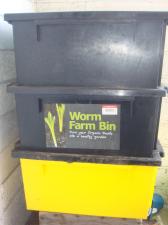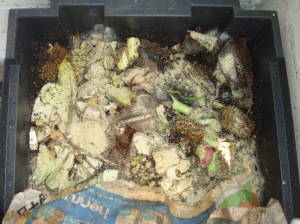If you want to know how to keep worms then you’ve come to the right place. I’ve had worms for about three months now and I’m ready to start sharing them with others. I put them on trademe to thin out my population a bit and help someone else get started. Worms are another trademe item that sells for too much, in my opinion. I aee most auctions for tiger worms (aka red worms) starting at $23 or even $27 for 500 grams. Worms double their population every 6 weeks in the right conditions, and they don’t exactly eat caviar (unless that’s what you’re throwing into the compost bin after dinner!). They can be free to setup and will populate quickly. In other words, they should be nearly free to obtain by anyone.

My worm farm has three bins: 1 for catching worm tea, and two to rotate the worms and collect the compost
What worms like to eat:
- Fresh vegetable scraps
- Fruit peels (except citrus)
- Small amounts of hair
- Coffee grinds and teabags
- Avocado skins
- Manure
- Egg shells
- Tissue paper
- Leaves
What worms don’t like to eat:
- Citrus
- Onion peel
- Meat (you’ll attract pests)
- Dairy products
- Lawn clippings in large quantities
- Spicy food
Some common problems:
- Worms are all going to the bottom of the pile:
- Not dark enough, add carpet or newspaper on top
- Lots of little white worms or flies:
- Too acidic, add lime or newspaper or eggshells
- Worms are trying to climb out the top of their housing:
- Too wet, add strips of torn newspaper to soak up excess water
- Worms are looking bloated or pale:
- Too wet, add strips of torn newspaper to soak up excess water
- The worm farm smells bad:
- Too much food, food is decomposing rather than being eaten

I've overfed my worm farm causing some food to rot so I need to add lime to get rid of the white worms and fruit flies.
Once the worms have gotten established they are going to increase in population according to the size of their home and food supply. Over time they will be able to consume more and more food scraps daily, and will be producing more and more of the good stuff for your garden. The two products you will be interested in are vermicast or castings, which is the stuff that the worms leave behind after they eat your scraps, and worm tea, which is the liquid which the worms deposit and will fill the container beneath your worm farm. Both of these are very rich fertilisers which will accelerate the growth of your plants.
Harvesting the Compost
Harvesting the worm castings involves migrating the worms to another area so that you can remove the compost without destroying your worm population. If you’ve bought a worm farm then it probably has more than one layer. This is so you can migrate your worms to the upper layer to harvest the lower.
To migrate the worms, simply put some bedding and food in the top layer and remove any carpet or newspaper at the top of the bottom layer so that worms can climb through. Once they have eaten all the food supply in the bottom layer they will climb up to the food source and you can remove the bottom layer with all the good compost in it. If it has some worms in it this is not a problem as they can go in the garden and still benefit you (or to the chickens!). Most of the worms will have moved up. If you don’t have an extra layer, you can also migrate your worms sideways to the left or right and harvest the compost on the other side of your container. This is how I manage my large worm farm.
Some worm farms have a tap at the bottom so you can just pour the worm tea into a container and apply it at a ratio of one part worm tea to ten parts water (1:10) and apply to your tomatoes or most prized plants. It’s best to do this straight away as there are lots of good bacteria in there which will die quickly.

No comments:
Post a Comment